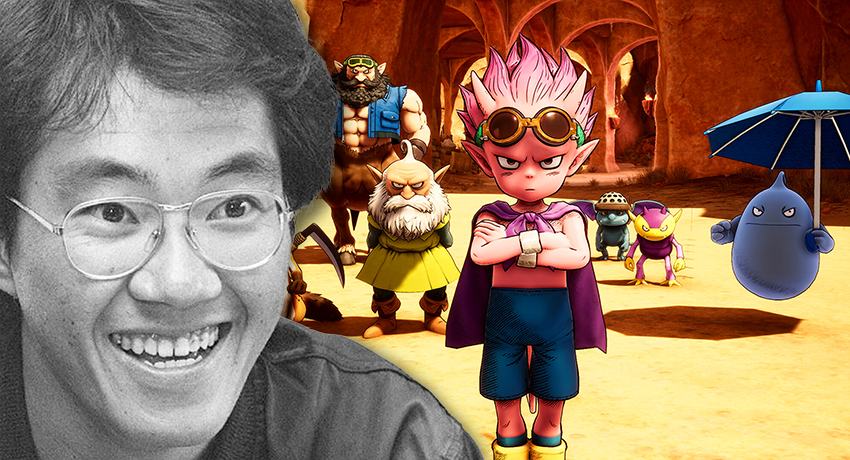Review: Sand Land
The death of Akira Toriyama, the manga artist and author best known for Dragon Ball, hit me hard when news of his passing hit in March of this year. Toriyama’s most influential series was hugely important to me growing up, and now that I’m in my 30s I can say with some confidence that it’s going to stay important to me for the rest of my life. It was only really when he passed that I realised I had never spent any time with his other creations: Dr Slump, Neko Majin, Jaco. I loved his work on games like Dragon Quest and Chrono Trigger, but had never gone deep on his back catalogue. Why not, I wondered, when Dragon Ball had meant so much to me?
This is the mindset I came to Sand Land with – this was an opportunity to enter the wider world of Toriyama’s work. This game adapts the anime version of his manga of the same name, which featured both the storyline of his original 2000 comic as well as a new storyline and characters created by Toriyama before his death. It has a lot of the aesthetics and objects I recognise from Dragon Ball – beautiful vehicle designs, super-expressive faces, capsules, dinosaurs, vast open plains. The game leans into many of the things fans of Toriyama might want to see, and his art style is rendered beautifully in the game’s visual style. As fans continue to mourn, this is the most obvious appeal of Sand Land – it’s a new Toriyama world for us to spend time in. And while it’s not a perfect game, it definitely delivers on that front.
In Sand Land, you play as Beelzebub, a small demon boy with a heart of gold that he desperately wants to keep hidden behind a veneer of evil. At the beginning of the game’s story, Rao – an old man who clearly has a troubled past he’s hiding – approaches the demon village that Beelzebub lives in. He needs assistance in locating a legendary spring, a potential source of water for his home village, which has – along with the rest of the titular Sand Land – been living through a terrible drought caused by human actions several decades earlier. Lured by the promise of a new gaming console as a reward, Beelzebub and his companion Thief set out with Rao to seek out the spring.
Sand Land presents a vast open world, full of hidden areas and secondary missions, and over time you’ll be able to build up a huge collection of vehicles to explore the land with. These vehicles are all outfitted with weapons, and a major part of the game involves doing battle with roaming enemy forces and wildlife you encounter. The game tends to be at its best when you’re piloting a tank, facing off against an enemy force, plotting out the best attacks and counter-measures as they bear down on you. The combat is less enjoyable when the game contrives to remove you from a vehicle and fight enemies on foot – the brawling mechanics are loose and over-simplified, but Beelzebub is fast and responsive, at least.
The mission design of the game is rarely particularly inventive: travel to a new location, combat the enemies there, collect loot, return to your base, purchase new vehicles or upgrades, go to the next location, rinse and repeat. Sand Land is repetitive, with little enemy variety and few moments that feel truly inventive. But still, I found myself enjoying being able to exist in this world. I love the classic Toriyama vehicle designs, with their rounded edges and their cool squished-in bodies. I enjoyed tearing across the sands on a motorbike, blasting giant scorpions. It inspired me to start watching the anime (available on Disney Plus in Australia), which is a lot of fun, too.
There’s a lot to do in Sand Land, but I did find that, after completing the first half of the story (the point where the original manga ended), my attention began to wane. There’s a clear point where it feels like the story is ending, but it’s actually just the midway point, and there’s a level of catharsis and resolution at this moment that makes it feel odd when the game simply continues. I was grateful that the game wasn’t as short as it initially seemed, but it was around this point that the repetition
started to make missions feel like more of a chore. There’s still plenty to like in the game’s back half, though, and blasting through an enemy vehicle with your tank remains entertaining throughout.
Akira Toriyama left a huge legacy behind him, and I’m grateful to Sand Land for giving me a reason to connect with a work that has been, until recently, far less known in the west. Like Dragon Ball, it’s a beautiful world full of wonderful objects, where bad guys can be convinced to turn into good guys with enough coaxing, where dinosaurs still exist. Exploring a world that Toriyama didn’t live to see realised in this way also made me a little sad – but there are worse feelings than the sadness that comes from missing a great talent.
Sand Land is available now on PlayStation 4 and 5, Xbox One and Series S/X, and PC. A PS5 code was provided for review.
James O’Connor has been writing about games since 2007.













